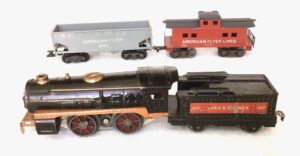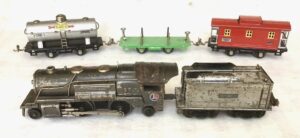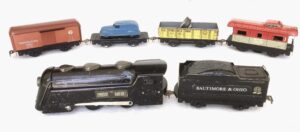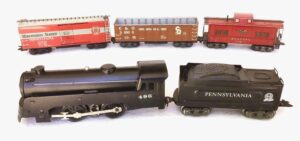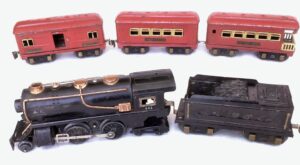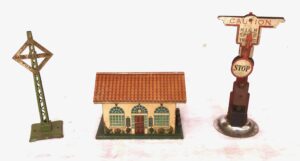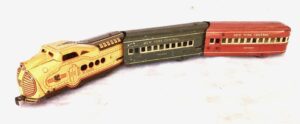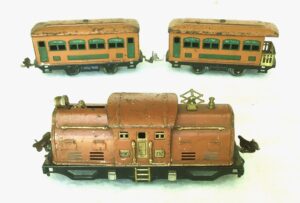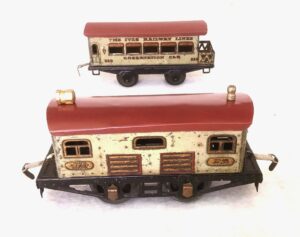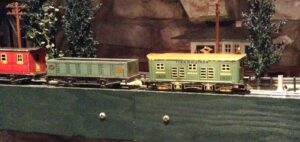COLLECTING TINPLATE ON A SHOESTRING
By Harry Noble (aka Cinder Sam)
Collecting is part of the model railroading hobby. There is no rush; the fun is in the chase. In my case there is no real goal. Although I must confess that my acquisitions seem to follow a pattern: 1- older trains from about the time when I was born, 2-historic model interest, 3-steam profile, 4-electric profile. But they all have to run (or be fixable) and fit O-gauge track. Fixable is best because I love building kits (think Varney/GMC ten-wheeler) and the cost is less. The end result is never in pristine condition, but all look like the real (toy) thing and they come with a history as shown by accumulated playwear.
I do like the detail in die-cast locomotives and plastic freight cars. However, one can kitbash more easily with prewar sheet metal (tinplate) rolling stock. I have also found there is a lot of interchangeability between manufacturers, in the form of wheels, couplers and physical size. Common screws and junk box parts come in quite handy too. Painting is mostly avoided, but a black permanent marker sees frequent use.
In this article I will share photos, acquisition notes and fix-up methods for a number of sets and singles that I have or did own. They all fit nicely on various “027 starter oval” display layouts I’ve built. While the track is O-gauge between the rails, actual rolling stock sizes vary from 3/16 scale (1:64 ratio) to ¼ scale (1:48 ratio). I like to call them SCALEPLATE trains. Each different layout (another story) has a specific purpose.
Ives-Lionel steam set (later called Winner, Lionel Jr. then 027)
Loco #1815 (Ives) or #1015 (Lionel 1931-32) O-gauge 3/16 scale
Tender #1507 (Ives) correct profile, but marked for #1506 windup loco
Hopper #640 (Am. Flyer postwar Gilbert) S-gauge 3/16 scale
Caboose #24635 (Am. Flyer postwar Gilbert) S-gauge 3/16 scale
I acquired the locomotive two years ago in a $100 grab bag (or rather a grab “box”) that also contained four other locos, some cars and a station. Two locos and the cars were immediately resold to recoup my cost. This little bugger was kind ‘a cute, the first I’d seen in real life, so I kept it. Ives originally designed it for a clock work drive and Lionel’s electric motor version has only one third rail pickup and no reverse. No problem, since I use Marx pre-war style manual switches (without gaps) on my big layout. Side rods are missing but cannot be replaced because the front and rear drivers have been swapped and I am not going to chance repeating the process. There was no headlight trim ring in the boiler front (maybe it was missing?) so I elected to add one. It’s part of a ham radio coax cable fitting that fits and looks great.
The matching Ives tender was found a year later at a local train show. It was near closing time, and I paid five bucks for it. No problems with this piece, and it shows nominal playwear.
My two American Flyer train cars were picked up previously at different train shows with the original idea being to compare them to Marx Scale cars. Their link coupler trucks were easily replaced with Marx Scale trucks having slotted forked type couplers intended to connect with tab couplers as found on Marx 6-inch 4-wheel rolling stock (and like used on this little Ives 4-wheel tender). While they did not match my Marx equipment too well, they seem just right here. Previously, I had tried some of those Marx 6-inch cars with this Ives loco and tender; and they seemed out of proportion. The only drawback with these two post-war cars is that they are plastic, and not tinplate rolling stock. So, I’m still searching.
Lionel steam set
Loco #259E (Lionel 1936-38, gunmetal color) O-gauge ¼ scale
Tender #261T (Lionel 1935) appropriate profile, unpainted nickel
Tank car #804 (Lionel 1939) ¼ scale
Flat car #831 (Lionel 1939) ¼ scale
Caboose #807 (Lionel 1939) ¼ scale
I bought the locomotive at an antique mall several years ago for just $25. A couple of parts were missing, and it wouldn’t run. Turns out the reversing e-unit needed a new ratchet drum ($5); which was difficult to install without bending the little wiper fingers. Afterward it ran very well. The missing die-cast headlight was replaced by a Marx headlight trim ring (another $2) that actually looks better. A missing number plate insert was corrected by computer printing “259E” on paper and trimming it to fit.
Greenberg says the tender should be a #1689T “coffin” style, which I do have in black. However I found a 261T at a train show for just $1 that is appropriate for this series of locomotives. A previous owner had replaced Lionel’s fabricated trucks with equalized die-cast ones. Remnants of aftermarket black paint were quickly removed to leave a nickel finish that nicely complements the loco’s gunmetal color. Missing side ladder and top handrail were added from junk box parts.
An older set of tank, flat and caboose cars was available from a defunct (zinc pest wheels) Lionel #248 loco outfit, I but opted to use these slightly newer, better condition, models. Purchase of same required a three year wait. The local county historical society has an HO gauge display, so attendance at trains shows to sell excess unneeded donated items in order to support their display activities. I helped them book price this set at $40 per car. Since no buyers showed any interest, the society gradually lowered the price over the ensuing years. When finally tagged at $10 each, I bought the set of cars. They even came with boxes!
Marx NYC 6-inch steam set
Loco #597 (Marx Commodore 1934-52, wind-up or electric, black) O-gauge 3/16 scale
Tender #951 (Marx wedge type 1939-58 on 4 or 8-wheel chassis), also used #551 wagon top 4-wheel
Box car #78500 (Marx-Carstens 1937-1954 on 4-wheels) 3/16 scale
Flat car #562 (Marx 1937-1954 on 4-wheels) 3/16 scale
Gondola car #241708 (Marx 1953 on 4-wheels) 3/16 scale
Caboose #20102 (Marx 1947-54 on 4-wheels) 3/16 scale; #556 on 4-wheels 1937-54 is more common
My electric powered locomotive was in a grab bag deal and ended up costing nothing. As received it would not run. The problem was in the reversing unit, which is a bear to get to and work on. Since this isn’t a switching loco, I just by-passed the problem and wired the motor to run forward only. This it did very well, and with good speed control too. Note that I often take this approach because my small display layouts have no switches. Although black is most common, Marx liked bright colors and produced a red Commodore. The model’s finish showed a lot of handling or playwear in the form of paint nicks; so a black permanent marker was used to make them less obvious. Note that all the trim pieces with bent tabs are easily removable and the body shell could have been easily stripped and repainted.
With Marx, tenders are a mix and match thing. Nearly any tender can be paired with any locomotive. Some combinations just look a whole lot better. Prewar, the skinny wagon top style was commonly used because it cost less to make. But the wedge type better matches the loco’s wide cab roof to the narrower car bodies. I choose to use a 4-wheel wedge when pulling 4-wheel 6-inch cars. An 8-wheel version goes better with Marx’s “scale” cars. This repainted and relettered tender ought to be marked NYC.
My freight cars displayed with this “set” are off-the-wall kitbashes. I will explain. The boxcar started as a wagon top tender, whose body was repainted primer brown. To this I applied HO gauge paper boxcar sides cut from a Carstens RR Model Craftsman magazine (mid 1960s era I think). Gluestick was the binder I used to avoid wetting the paper sides. Next attached, by instant glue, were thin rectangular (prepainted body color) pieces of plastic or metal to simulate the doors. Last step was to instant glue 1/16 square lengths of plastic or matchsticks (black permanent marker) to represent door guides. Done, and unique!
The flat car is simply a chassis with a Tootsie-Toy (childhood) vehicle attached. Most chassis have a center hole to aid in your jury-rigging the connection. Don’t make this too permanent as you may later want to change loads or put the vehicle on a layout. I suggest lumber, crates or barrels as alternate loads. Except for some early prewar cars, all chassis will be black in color.
Gondolas are a dime a dozen; actually $1 as well used, to $5 or more depending on dealer and condition. My intent for this item was to make a searchlight car. I couldn’t find a factory model to purchase, so I used what was at hand. The light is a 35mm film can lid drilled to pass a 12 volt screwbase bulb. The bulb goes thru the lid, plus an aluminum 45 degree bent angle bracket, and is secured with a thin electrical nut (table lamp shade support rod nut). Said bracket then was secured to the car chassis thru its center hole. My electrical pickup is a small block of wood (centered on one axle with ballpoint pen springs) to which a piece of bent brass strip has been attached. Solder a wire from this strip to the base of the bulb and you’re finished. Not fancy, but it works.
Lastly (no pun intended) is a lighted caboose. Marx made this car in two versions; mine started out as the unlit one. I cured this problem by simply swaping my caboose body to a lighted observation car chassis. The only thing that I had to do was bend the drumhead bulb and socket back into the car body area. My old observation shell was so rusty it was scrapped.
Marx C.P. Scale steam set
Loco #496 (Marx 1939-52, once marked “3000” now repainted) O-gauge 3/16 scale
Tender #951 (Marx wedge type 1939-58 on 8-wheel chassis. Repainted & relettered)
Box car #37953 (Marx 1950-58 re-trucked 7-inch) 3/16 scale
Gondola car #36000 (Marx 1956-57 re-trucked 7-inch) 3/16 scale
Caboose #92812 (Marx 1950-58 “scale”) 3/16 scale
I talked my son out of this rusty old shell because I wanted to remodel it into a nice straight forward modern steam locomotive. The shell was already stripped of appliances so it got two coats of black paint. New parts in the form of headlight lens, marker shrouds, dome and whistle came from supplier Grossman. These, plus 44-40 cartridge case smokestack, hardware store handrails and cotter-pin standoffs were put in place before numbering. The #496 applied is one digit higher than Marx’s 494 and 495 “3000” locos, and seemed appropriate. Power comes from a practically new #490 plastic loco double reduction motor. Last thing needed were the piston cylinders used where the motor fastens to the lower front of the boiler. As I’ve done before, these were made from bent ¾ wide brass strip painted black. Turned out nice.
A scale wheeled tender goes best with scale wheeled cars. I chose one with a slotted plastic forked and tilting rear coupler, because it can pull both Marx scale and 6-inch cars, as well as other makes with tab couplers. This used tender was repainted and reletterd to match my locomotive.
Marx lithographed 7-inch 4-wheel cars are actually scale designed models; just a half inch shorter. I’ve modified (kitbashed) all four bodies (2-boxcars, 2-gondolas) to add more variety to my scale car collection. The change is quite simple. Remove rivets holding knuckle couplers. Remove large wheels and axles. Snip off tabs that held axles to chassis. File cuts smooth and paint black with permanent marker. Next, carefully straighten tabs and separate body and chassis. Install good used scale trucks with new rivets. (A rivet punch really helps one do a proper job and costs very little; contact Grossman.) Reattach body to chassis and twist-not bend-tabs to secure. Bent tabs are more likely to snap off. Believe me! Easy fun project.
The caboose is a totally unmodified Marx “scale” item. Only thing I’ve ever done on one is scrounge the rear coupler for use elsewhere. Not recommended; can mess up switching. (Hint-some prewar cabooses have holes in the sides near top rear. These are for adding rear markers. Lionel cast loco markers should work nicely in this application.)
Chicago American Flyer steam set
Loco #401 (Am. Flyer 1935-36) O-gauge ¼ scale
Tender #?? (Am. Flyer 1935-36) ¼ scale (wagon top design also cataloged)
Baggage car #?? (Am. Flyer 1930s) ¼ scale
Coach #?? (An. Flyer 1930s) ¼ scale
Obsercation car #?? (Am. Flyer 1930s) ¼ scale
This complete set came via my son, whose relatives found it in an older house they had just purchased. Condition is generally good. Not much play wear but shows some light surface rust from age. Chicago American Flyer was not too concerned with numbering on its products, so I can’t be specific about the actual year this equipment was made. Gilbert Flyer apparently carried this one inexpensive set design over to its own production, as shown in their first two catalogs, but assigned them new piece numbers.
My locomotive seems taller than most contemporary steam profiles, and the 2-4-4 wheel arrangement is a bit odd. It came with some operating issues that were corrected without disassembly; the most serious being zinc pest in the smaller wheels. As luck would have it, I had prior experience fixing up two similar prewar locos for a friend.
This tender looks like a tender should; with coal storage space and water tank. I’ve seen pictures of their wagon top design, similar to that of Marx, in sales catalogs and on internet forum sites. It reminds me of an oil tender used by some western railroads.
The three passenger cars are sturdily built and each rides on a pair of simple 4-wheel trucks. According to several of my reference books, they were also made in a fixed four wheel version (yet were cataloged with the same old model number). A form of automatic coupler is an interesting design that was new to me. It’s made of sheet metal formed in a curly-Q shape that looks like a knuckle. As a matter of fact, I have found they will connect nicely with both Lionel and Atlas modern knuckle couplers.
Accessories
Station & transformer #1012 (Lionel 1932) 3/16 scale
A neat little scenic item. Not oversized as some stations are. Found in my grab bag. (I also own a Marx Girard whistle station, closer to ¼ scale, that fits well with later prewar 027 passenger cars. It’s too small for the #800 series Lionel 4-wheel freight cars mentioned in this article.) Anyway, there is a transformer built into this station. It has two fixed taps in the 6-8 volt range; which is too low for operating most trains. Close though for the little Ives-Lionel steamers and electrics made in the same time frame. It’s probably better though for low voltage house or street lights. Lionel had another, near identical, station (#1017, winner 1933) that is listed as having a transformer. Some others may have had a speed control lever protruding from the end. The basic structure is also noted in Greenberg as having a whistle.
Marx U.P. Streamliner diesel set
Loco Marx M10005 (wind-up 1936-52, electric 1940-52, #735D dummy 1951-53) O-gauge 3/16 scale
Passenger coach #657 gray (Marx 1938-40 articulated) 3/16 scale
Passenger observation #658, red (Marx 1937-40 articulated) 3/16 scale
My son picked up this M10005 unit (U.P. City of Denver train) as part of an estate sale. Being only an unpowered “D” version, he passed it on to me. The thin lithographed shell has no chassis per-se. Holes are pierced thru the lower part of the body for inserting wheel and axle assemblies. A nose coupler allows the unit to be pulled in a train as a “helper”. Made from standard dies, it has a slot opening in the roof for a clockwork drive start-stop lever and interior attachment points for electric motor mounting. Using the latter, I inserted a spare motor that I had on hand. Of course it runs!
The mismatched trailing cars Marx made from M10005 dies, but painted and named them for the popular NYC Mercury articulated train. (On which Marx used a steam profile loco.) This compact set is about the shortest outfit that I can operate on my display layouts. It occupies only three sections of the twelve total pieces of track on each. Once more, it disappears completely into the tunnels.
Lionel NYC electric set
Loco #252 (Lionel 1926-32) O-gauge ¼ scale
Passenger coach #629 (Marx 1924-32) ¼ scale
Passenger observation #630 (Marx 1924-32) ¼ scale
This electric profile, hand reverse (lever thru roof), locomotive was found in a box under a table at a train show several years ago. Paint was pitted, appliances were missing, and the motor wheels were frozen with zinc pest. But, for a price of $5, I brought it home. A good week’s work was necessary to bring it back to useable condition. Appliances came from a Lionel #248 electric loco. That was the easy part. Wheels were something else. The old ones were pulled off their axles and brass drive gears saved. Replacement wheels came from a non-working plastic framed Scout motor. I gel glued my saved gears onto the backs of the plain drivers using small hex nuts to center them. Gears were sawed off back of the other two drivers and all four wheels bored out to fit the 252 axles. I then gel glued all replacement drivers onto the 252 axles. Be very careful to get all gears in alignment! The mashup actually works. My replacements are a fraction smaller in diameter and don’t have nickel rims, but no matter. A ninety-year-old relic is saved.
Again my son helped repay his college education by finding and gifting me with two matching passenger cars, completing the set. They are older models, without journal covers, but their color and condition are the same as my loco shell. Note: back in the day, train sets consisting of a loco and only two cars were common.
Ives New Haven electric set
Loco #3259, white color (Ives 1927) O-gauge 1/4 scale
Passenger #551 (chair car) and #552 (parlor car) are missing from this “White Owl” set
Passenger observation #558 (Ives 1927) 1/4 scale
1927 was the last full year of true Ives Corporation manufacturing. The following year saw bankruptcy and buyout by Lionel and American Flyer. Thus followed a 4-year “transition” era. So, even though I have only a partial economy set, it’s still a true Ives product. From the grab bag I mentioned earlier.
This locomotive is in very good shape but came roofless. A metal beer bottle found in my front yard supplied pre-formed arched material for replacement. Being a slide-on type roof, making the crimped edges was the hardest part. Doyle’s Collector’s Guide and a TCA data sheet provided me with the correct paint color: bright red. Rooftop appliances are a whistle (screw-on spark plug cap) and headlight (aircraft tire valve stem cap). Lionel copper journal covers are close duplicates for three that were missing. Note that some of these economy locos came sans journal covers. In addition, they were the first to be made with a sheet metal formed chassis in lieu of cast iron. Reversing is accomplished by moving a lever that protrudes from the side of the chassis.
While this is a passenger set, Lionel later included its #804 tank car and #807 caboose in a freight set (or so I’ve read). The one remaining observation car included here is very light in weight. It was also minus roof. Coloring, loco too, is supposed to be white like the set’s name, but appears as gray to me. So much for aging gracefully!
Ives-Lionel New Haven electric set
Loco #1810 (Ives-Lionel 1931-32) O-gauge 3/16 scale
Gondola #1512 (Ives-Lionel 1931-32) 3/16 scale
Caboose #1517 (Ives-Lionel 1931-32) 3/16 scale
This is another lithographed economy set from the transition years. It was the last piece found in my grab bag. The loco’s motor is identical to the little steamer covered earlier. No reverse. Runs on much less than 12 volts. Two excellent condition freight cars completing this original set are very similar in looks and construction to most Marx 4-wheel 6-inch cars, only lighter. I apologize for the older photo. It cannot be retaken, because the set was resold to pay for other items in the box and for my disinterest at the time.
And so, what will happen next on my adventure?

